Grapes, like other crops, are prone to diseases and pests. The gardener's task is to preserve his health and get a rich harvest. The leading role in the difficult struggle for a healthy garden is given to preventive spraying with chemical and biological preparations.
Content
Why you need to spray grapes
Pathogenic spores are in the air, localized in the soil, “sleeping” on weeds throughout the season. They are constantly waiting for the appearance of comfortable conditions for revitalization. You can’t protect yourself from the appearance of diseases by preventive measures alone. Therefore, special agents were invented that suppress the aggressive pathogenic environment and stop the development of the disease.
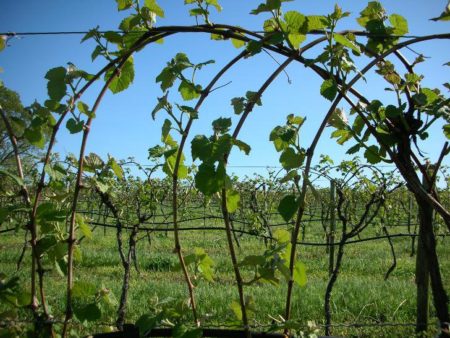
Terms of processing grapes from diseases and pests
It’s better to start processing the vineyard earlier than to be late and start the bushes altogether. Spraying must be carried out in several stages according to the seasons:
- In the spring. Processing of grapes in the spring from diseases and pests is carried out for the first time as a preventive measure, as soon as the snow melts and access to the grape bushes opens. It is important not to miss the moment - all chemical treatments are carried out before the first leaves bloom. If during the inspection of plants no diseases and pests were detected, then for prevention wood is sprayed with iron sulfate. Spring treatments are purely preventive in nature, that is, they protect, but do not treat plants.
- Summer. Spraying grapes is carried out before flowering, or during the formation of fruits. When the first alarming signs of the disease appear in grapes in summer, systemic fungicides are used, for example, Strobi, Topaz. Ripening ovaries can be irrigated with Bordeaux liquid, copper chloride and colloidal sulfur.
- In the fall. Processing of grapes from diseases and pests wintering in the soil is carried out after harvesting, before the onset of steady colds, the vineyard is sprayed with iron sulfate. This substance covers a thin layer of all wood and thus protects the shoots from temperature fluctuations.
The most dangerous grape diseases
Vines are often exposed to diseases such as powdery mildew, rot, bacterial cancer and others. All these diseases pose a great danger not only to the vineyard, but also to neighboring plants. You can suppress the infection in the early stages and only if the infection was detected on time and the diagnosis is correct.
Mildew
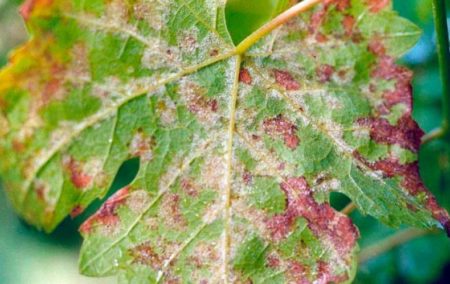
False powdery mildew is a fungal disease. Causes yellowing and drying of leaves, stems, berries.
Symptoms: the underside of the leaf is covered with yellow oily spots. A whitish coating appears on top - sporulation of the fungus. The disease manifests itself in a humid, warm summer. Without treatment, the bush completely dies in a month.
How to process grapes: to combat mildew, treatment with complex means is needed (Delan, Antracol, Azofos, Ridomil Gold, copper-containing preparations). For prevention, the drug Hom, Bordeaux fluid (1% solution), Tsineb is used.
Oidium (powdery mildew)
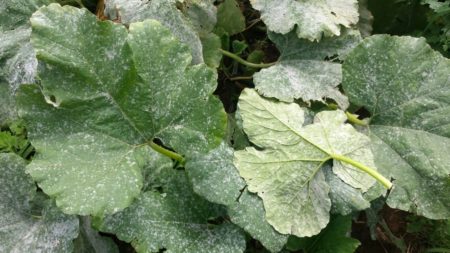
By the symptoms, this disease is very easy to recognize. The leaf plate is completely covered with a white powdery coating. The stems and leaves stop growing. Their color becomes pale. With the development of the disease, dark spots appear on the green, which, as it were, burn out the leaves. They twist, the ends die off. Affected leaves fall over time. The disease can also be localized on the fruits - the ripeness of the berries does not occur. The disease can manifest itself during flowering. At this time, brown spots may appear on the wood - this means that the infection spreads through the bush at a rapid pace and it is necessary to take immediate measures, otherwise 99% of the inflorescences will die.
To process grapes from powdery mildew you need sulfur-containing preparations (colloidal sulfur, Topaz, Topsin).
Rot
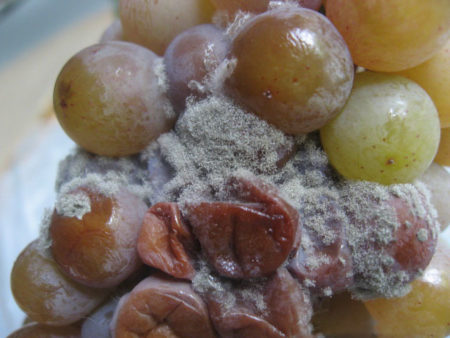
This fungal disease can not be confused with any other. Affected areas of the plant begin to rot, that is, moist gray putrefactive changes appear on the leaves and fruits. Infection develops at a rapid pace in a humid and warm environment, and in the summer heat it stops its development. The places of decay gradually dry out, and the leaf plate falls off.
Than spraying grapes: in the treatment of rot use drugs such as Fundazole, Topsin M, Topaz, Kaptan and others. It is advisable to process grapes from gray rot with potassium iodide. As a prophylaxis, the treatment is performed by Mikal, Antracol.
Anthracnose
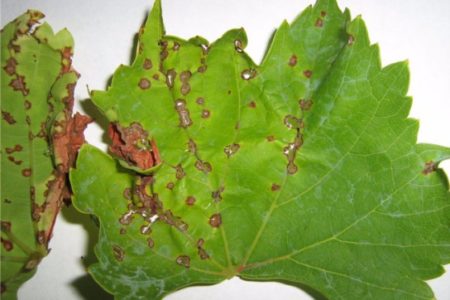
In rainy summer, the probability of anthracnosis is high. The disease manifests itself in the form of small black dots on the fruits and leaves. Berries crack, wasps begin to eat them. The bark crumbles, shrivels, green tissues are exposed. From anthracnose, grapes are systematically processed throughout the season. Copper-containing preparations alone are not enough - an integrated approach is needed here, including spraying with contact and systemic drugs, cleaning the area, and airing.
Bacterial cancer
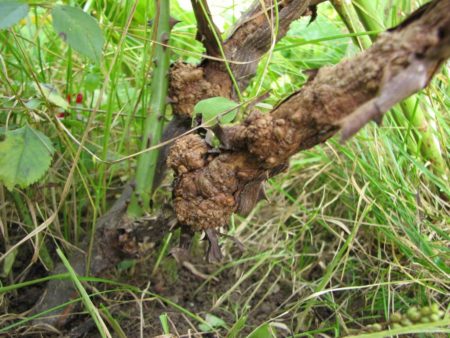
The causative agents of infection are bacteria. Cancer affects the superficial layer of the vine, causing necrosis of the captured areas. Usually the disease appears in the lower part of the trunk. The foci can be very small or have impressive dimensions. Bacterial cancer suspends all biological processes of the plant. The sap flow is disturbed, the shoots become thin, fragile. If the foci of the disease are small in size, then they are cut out, and the cut points are smeared with copper sulfate. Processing of grapes with hydrogen peroxide will not hurt. It is also necessary to carry out treatment with immune preparations.
Folk grape processing methods
Many gardeners are in no hurry to poison the grapes with pesticides, preferring to fight diseases and pests with folk methods. Spraying grapes with baking soda, potassium permanganate and iodine will help cope with many fungal diseases.
Soda solution
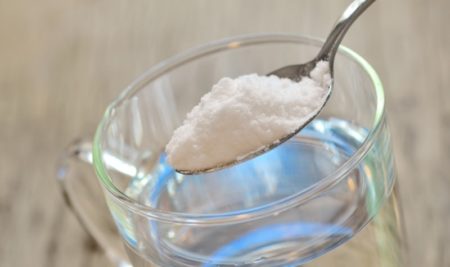
Processing grapes with soda is an excellent prophylactic against gray rot, mildew and oidium. Soda helps get rid of caterpillars and clean leaves.
Pros:
- soda solution promotes the rejuvenation of plants;
- treatment with soda leads to the destruction of weeds;
- berries treated with soda solution become sweeter.
How to cook apply soda solution:
- From gray rot - 70 grams of soda to a bucket of water with the addition of sunflower oil and grated soap.Treat the affected parts of the plants with a ready-made solution.
- From oidium - a liter of water and a teaspoon of soda with the addition of liquid soap. Spraying is carried out regularly throughout the summer with an interval of two weeks. Finish processing the grapes in August, when the fruits began to ripen. Do not process during flowering.
Potassium permanganate spraying
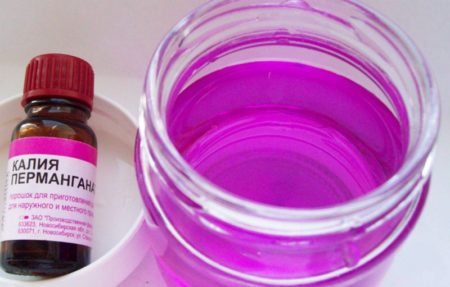
Potassium permanganate usually acts as a protective agent. With a solution of potassium permanganate, seeds and roots of seedlings are disinfected. It is treated with plants during the ripening of berries, when other fungicides cannot be used.
Benefits of potassium permanganate:
- economical tool: to prepare a solution you need only 1 gram of substance;
- if potassium permanganate is mixed with boric acid, then a good foliar top dressing will be obtained;
- potassium permanganate is much cheaper than other drugs, and in many cases it copes no worse.
Minuses:
- excessive concentration of potassium permanganate can lead to inhibition and degeneration of plants;
- potassium permanganate is used only in slightly alkaline soils.
How to prepare and apply manganese solution:
From oidium - 5 grams of manganese is dissolved in 10 liters of water. Water should turn a light pink color. Such a concentrate is suitable for prophylactic treatment. If the disease progresses, then the proportion of manganese is increased to 9 grams
Grape iodine
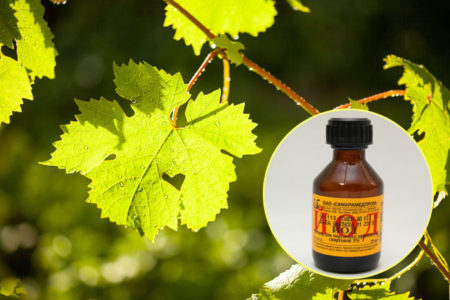
Iodine helps to avoid the appearance of mildew. However, it is effective only as a defense. In addition to the protective properties, iodine enriches the plant, improves the taste and healthy qualities of berries, helps the root system to better absorb nutrients, so useful spraying is mainly carried out during the ripening period of the berries. The usefulness of this element is invaluable, although it can harm a person if these treatments are abused. Iodine can be diluted with water and whey.
The use of iodine:
- From oidium - 2 drops of iodine are needed per liter of water. The resulting product is watered with berries, which are most susceptible to the disease. You can sprinkle berries 3 times per season.
- From mildew - in a container mix 20 drops of iodine, 10 liters of water. 10 tablets of Trichopolum. Processing is carried out systematically with an interval of 12 days, starting from spring and ending with the fruiting period.
Grapes
To process the vineyard at different stages of its vegetation and the development of the disease, fungicides are used, which are of two types:
- Inorganic.
- Biological.
In turn, inorganic fungicides are divided into:
- contact;
- systemic;
- complex.
Contact
Drugs in this group are used mainly as a prophylaxis. They do not treat plants if the disease has already hit them. They can only protect the vine bushes from the penetration of the pathogen into the leaf plate. When spraying, the active substance reliably envelops all the organs of the plant with a thin but strong film through which no fungi and bacteria can penetrate. The advantage of such drugs is that they are absolutely harmless to plants and humans. Contact funds are not addictive in fungi, and therefore they can be used several times in a row.
In addition to the advantages of such funds there is a significant minus: the duration of the active substance is small, about 10 days. Then the processing will have to be repeated.
Treatment with contact preparations begins in early spring, even before the appearance of pathogenic bacteria in the garden area. The first spraying is carried out before the leaves bloom. During flowering, grapes should not be treated with copper-containing preparations.
Systemic fungicides
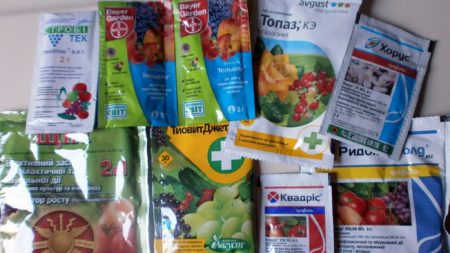
Similar drugs are used to treat already diseased bushes.Their principle is that the active substance penetrates into the plant and acts on pathogens directly on the "battlefield". The advantage of such drugs is that they reach the goal a few minutes after spraying and begin to affect the pathogen from the inside, blocking its vital functions. The fungus can no longer multiply. It is destroyed at the cellular level and will soon die.
Systemic fungicides are usually used at all stages of the development of the disease. Their effectiveness does not depend on weather conditions: they are not washed off by rain, do not evaporate in the sun. The duration of the drug reaches three weeks. The only disadvantage of a systemic drug is that pathogens eventually become resistant to one or another active substance. Therefore, repeatedly processing grapes with the same preparation does not make sense - the fungus will not respond to poison. It is recommended to alternate systemic fungicides containing various active substances.
Combined fungicides
Such drugs are also called complex. That is, they contain several active substances that not only treat the plant, but also exhibit protective properties not only against diseases, but also pests. In addition, in many cases, complex pesticides increase the immunity of plants, improve viability. The principle of their actions is as follows: one substance kills microbes inside the plant, another - affects the plant outside. There are even those that penetrate the roots and provide reliable protection from pests.Toxicity is considered a disadvantage of combined drugs: improper processing can lead to serious poisoning of humans and animals, death of the grape bush.
Biological products
Biological preparations are created on the basis of beneficial microorganisms that have certain properties. There are biological products that can affect insects, others - on pathogens, and others - to replenish the vitality of damaged plants. The advantages of biological fungicides include their non-phytotoxicity. They do not accumulate in tissues and fruits, do not harm humans and animals. They are not addictive in pests and pathogens. They have a relatively long service life. There are drugs based on fungi, bacteria, nematodes. They can handle not only grapes. But also the soil, seeds and roots of seedlings.
Fungicides
If the disease does not recede, then proceed to the processing of the vineyard with strong chemicals.
The best fungicides:
| Title | How to apply | Features |
| inkstone |
In the spring: 50 grams of crystals in 10 liters of water are bred to obtain a mixture. Autumn: 300-500 grams of powder per bucket of water. 1-2 treatments are sufficient with an interval of two weeks. |
Contact action drug. Does not penetrate into plant tissues. The substance is a bluish crystallized powder. It is well dissolved in water. The substance can be used as a fertilizer, fungicide, insecticide. It has a short-term effect, it is not able to fight bacteria. |
| Colloidal sulfur | As a prevention and treatment in the first stages of the disease. To prepare the mixture: 80 grams of powder per 10 liters of water. The resulting solution is enough for 60 square meters. | Inorganic fungicide of contact action. Suitable for combating fungal diseases. The emitted sulfur vapor destroys fungal spores at the cellular level. Processing can be done in spring with warm, clear weather before buds open and in summer until flowering. |
| Thanos | The working solution is prepared from 4 grams of substance and 10 liters of water. For the first time, grapes are sprayed before flowering. It is allowed to process bushes 3-4 times a season, every 12-14 days. | Systemic fungicide, consists of two active substances: famoxadone and cymoxanil. The first protects the plant from the outside, forming a strong non-penetrating shell. The second heals the plant from the inside, enveloping the pathogens with a film that prevents it from developing. The drug can be combined with other chemical agents having a neutral and acidic reaction. It is unacceptable to use with alkaline drugs. Multiple treatment per season is possible, as Thanos is not addictive in microorganisms. |
| Quadris |
For the treatment of grapes, a solution of 60 milliliters of suspension and 10 liters of water is prepared. For prevention - 40 milliliters per bucket of water. Can be processed during the season. |
Systemic drug. Suppresses the reproduction of fungal spores. A tool based on strobilurin mushrooms. Destroys all known pathogens of fungal diseases, acting from the inside. Quadrice is not dangerous for flora and fauna, quickly decomposes in the ground. It does not accumulate in fruits and berries. It has a long healing and protective effect. Effective at a temperature of + 4-30 degrees. It is recommended to alternate with other fungicides, since mushrooms quickly get used to the drug. |
| Topaz | A therapeutic solution is prepared on the basis of 10 liters of water and 2 milliliters of viscous liquid. Processing is carried out 2-3 times per season. It is preferable to alternate with other pesticides. | Penconazole based product. Getting on a plant penetrates inside, it reaches fungal spores, blocking their vital functions. Recommended for disease prevention and treatment at the first stage of infection. It copes well with the suppression of primary infection. Instantly absorbed into plants, not washed off by rain. Processing can be carried out even at subzero temperatures. Validity - 14 days. An economical tool, since a very low concentration is needed to process the vineyard. |
| Falcon |
For spraying young plants, a solution of 3 milliliters of the drug and 10 liters of water is prepared. On adult grape bushes, the concentration is increased. For treatment of a progressive disease, 6 milliliters are already bred. The maximum number of treatments is 4. |
Three-component antifungal fungicide. It fights against diseases such as oidium, powdery mildew, spotting. It can be used as a prophylaxis. Getting on the pathogen of infection, active substances destroy it from the inside and causing an early death. Analogs of the drug are the preparations Horus and Topaz. Falcon is harmless to humans and plants, has a long service life. Loses effectiveness at temperatures above +25 degrees. The drug can be used to treat the berry throughout the growing season, including the flowering period. |
| Shavit - F | 200 grams of white granules are dissolved in a bucket of warm water. The first spraying is done before the bushes begin to bloom. After two to three weeks, the treatment is repeated. It is permissible to carry out 2-3 treatments during the summer. | Designed to combat various fungal diseases (oidium, mildew, scab, spotting, wilting, drying, rot). It consists of two active substances that, getting inside the plants, penetrate the spores of the fungus and corrode it. The advantages of Shavit include the lack of resistance and a multi-day period of action (more than two weeks). Safe for birds and animals. |
| Topsin -M | For spraying, prepare an aqueous solution with the addition of 15 grams of the substance. Processing is carried out during the growing season, bypassing the flowering stage. It is recommended to alternate Topsin with its analogues - Tsikozin and Peltis. | A broad-spectrum systemic drug.Theophanate-methyl active substance penetrates the plant organism within 30 minutes, causing damage to fungal spores, the development of mycelium. He is also able to heal microcracks and affected areas. Outside, the substance protects wood from aphids and other dangerous pests. Topsin is slightly toxic. Disadvantage: it is addictive in fungi, it is necessary to alternate it with other chemicals. Pesticide has a positive effect even on the roots of the vineyard, protecting it from nematodes. Topsin recommended handle grapes in autumn, after harvesting. |
| Grape lifesaver | The drug is contained in three ampoules, which are simultaneously diluted in 10 liters of water. 1-2 sprays are possible per season. | It acts as a fungicide and insectoacaricide. Helps to cope with mildew, gray rot, oidium, late blight, as well as weevil, aphids, caterpillars, thrips and phylloxera. It also acts as a regulator and stimulator of shoot growth. Toxic to humans, therefore treatment should be carried out in a protective suit. The result after spraying is stored for a month. |
| Bordeaux fluid | To prepare a 1% solution of Bordeaux liquid, you must first mix 100 grams of copper sulfate with 5 liters of water. Separately mix 150 grams of lime with water, bring the amount of water to 5 liters. Mix, strain and treat both mixtures. | The tool is used to cure grapes and protect it from infectious diseases. The use of Bordeaux fluid begins in the spring, before the buds open. Prevention with this tool allows you to protect grapes from black rot and mildew. Up to five grape treatments can be carried out during the season, including the flowering period. After rain, spraying must be repeated. Bordeaux liquid is an excellent source of calcium for grapes. |
| Ridomil Gold | An irrigation solution is prepared on the basis of 10 liters of water and 25 grams of granular powder. | Antimicrobial drug combined action. It copes with diseases and pests. It consists of two active components - metalaxyl and mancozeb. Substances perform the treatment and protection of all plant organs, including roots and fruits. Not phytotoxic, but dangerous for humans and animals. You can spray grapes up to three times during the summer. After rain and extreme heat, treatment should be repeated. |
Insect preparations
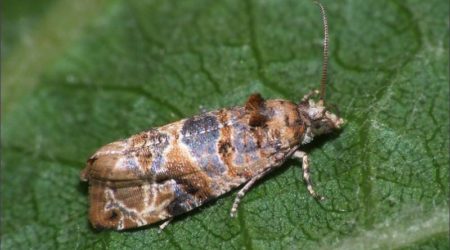
Grapes attack various insects that can reduce the yield of the bush to 50%. Pests get on grapes through weeds, by weed from other sites, through the soil. Most often you have to fight aphids, leafworms, ticks. Often a bee swarm settles in the vineyard, and it is also damaged by wasps. These annoying insects breed very quickly and are in no hurry to leave a favorite area even under the most severe pressure. Broad-spectrum chemical insecticides help cope with living creatures.
Popular drugs:
| Title | How to apply | Features |
| Nitrofen | To process the vineyard, a viscous mixture of 200 grams of pasta and 10 liters of water is prepared. | Opposes fungal diseases. Kills larvae and eggs of many pests. The substance acts on the pest through its intestines. Among the shortcomings: long stored in the soil, therefore processing is best done in early spring and late fall. |
| Actellic | A therapeutic agent is prepared from 2 milliliters of a substance and 1.5 liters of water. The finished product is enough to process 10 square meters. | The drug is intestinal contact. Kills pests, including ticks. It does not harm the plant itself, as it does not penetrate inside. Not addictive in parasites. Validity - more than two weeks. The tool relates to organophosphorus compounds. It is permissible to apply twice a season. |
| Bi-58 | For 10 liters, 2 ampoules of the drug are needed. Processing can be carried out 1-2 times per season. The latter should be carried out no later than 30 days before harvesting. | An emulsion based on phosphoric acid. Suitable for controlling various pests. The drug is a systemic and contact action. It penetrates organisms through the integument, causing poisoning. Actellic treatment increases yield, as it reliably and for a long time protects plantings from insects. It is necessary to re-process the grapes after rain. |
| Confidor Maxi | To prepare the concentrate, 1 gram of Confidor is mixed with 100 milliliters of water. Then the resulting solution is added to a bucket of water. The product can be used repeatedly during the season. | Contact and intestinal systemic insecticide. The substance is based on imidacloprid. Getting inside a living organism causes a malfunction of all organs, the insect dies. Efficiency depends on weather conditions. The result is saved up to 30 days. |
| Talstar | 400 milliliters of the substance are mixed with a bucket of water. The finished solution is enough to process one hectare. | Acaricide The active substance is bifentrin. It is able to destroy insects and ticks at all stages of development (larvae, eggs, adults). It also destroys sucking and gnawing insects. It has a long service life. Low toxicity. The first drug that can control the development of whiteflies. |
| Neoron | To process the vine from a tick, a solution is prepared, spending 20 milliliters of the drug per 10 liters of water. The flow rate of the working solution is 5 liters per 50 square meters. | Contact action acaricide. Little toxic to bees. It has a long protective effect. The drug can be combined with other chemicals. Precipitation does not affect the effectiveness of the insecticide. |
Disease and Pest Prevention
It is possible to keep the vineyard in good health if competent and regular prevention is carried out throughout the year. It comes down not only to pesticides, but also periodic inspection of bushes, pruning, watering and top dressing, tillage.
Preventive measures:
- Grow grapes in sunny areas with low groundwater.
- Water the bushes under the root so that the leaves remain dry.
- During prune grapes, removing all damaged, oppressed branches. There should be no thickening of landings. Air and sunlight should freely penetrate the center of the crown.
- Constantly monitor the cleanliness of the earth: remove weeds and fallen leaves, berries in time.
- Avoid condensation on the bottom of the bush.
- Fertilize properly. Nitrogen should be introduced only in the first period of the growing season. In mid-summer, the grape bush needs phosphorus and potassium.
- Mulch the area under the bushes with humus or compost.
- Garter the vines so that they are evenly attached to the trellis.
- All pesticide spraying must be completed 3 weeks before harvesting.
- In the fall, remove all plant debris from the site.
- Reliably cover the vines for the winterbypassing their freezing during cold weather.
Conclusion
Grape processing is necessary throughout the season. From a properly selected preparation and timely work to maintain the health of the vineyard, you can quickly get rid of a dangerous infection and, as yet few, a pest.

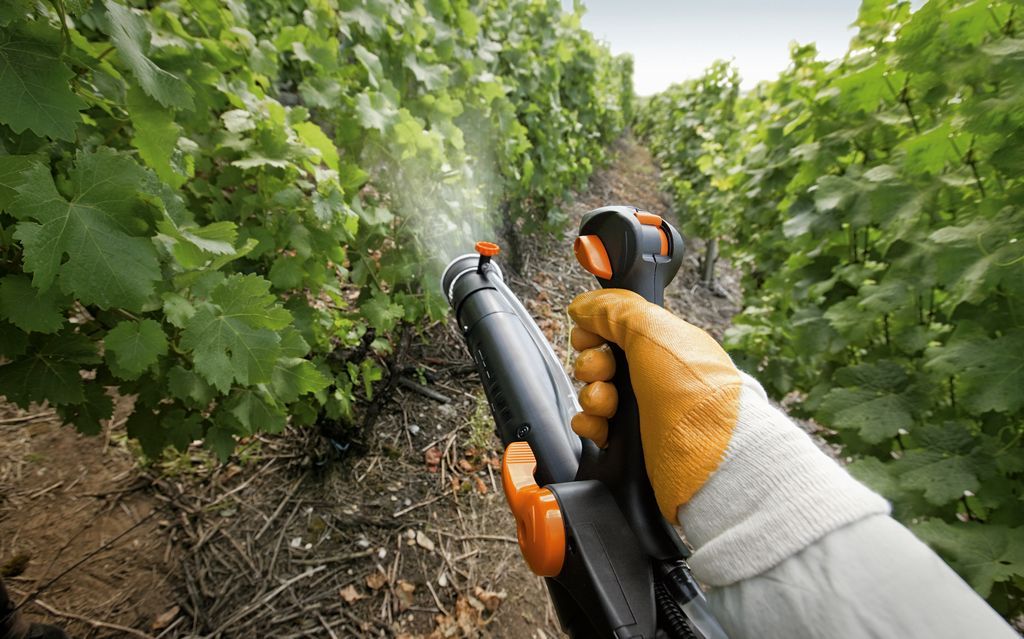



 Non-covering winter-hardy grape varieties for Moscow region
Non-covering winter-hardy grape varieties for Moscow region How to keep the vine in winter
How to keep the vine in winter When can I transfer grapes to another place in the fall
When can I transfer grapes to another place in the fall How to cover and prepare grapes for the winter in the suburbs
How to cover and prepare grapes for the winter in the suburbs